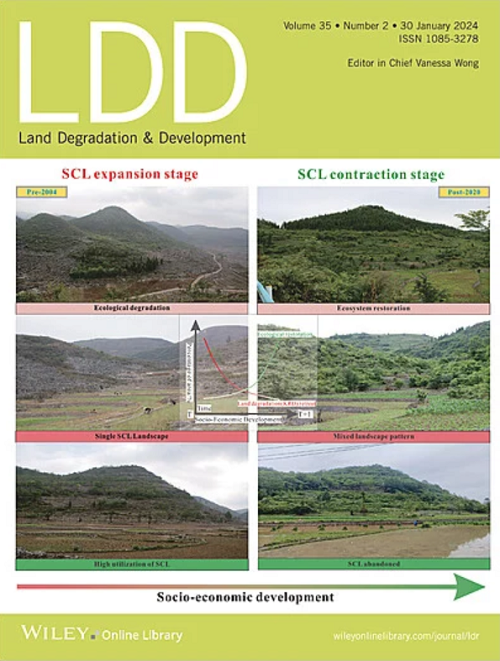天山北坡城市群生态系统服务的权衡与协同:社会生态驱动因素的视角
IF 3.6
2区 农林科学
Q2 ENVIRONMENTAL SCIENCES
引用次数: 0
摘要
了解社会生态驱动因素对生态系统服务之间的权衡和协同效应的综合影响(EST/ESS)对区域规划和治理的利益相关者至关重要。然而,对潜在机制的了解有限,阻碍了我们评估区域自然和社会进步过程中社会生态驱动因素配置对EST/ESS的影响。本研究建立了基于生态系统服务功能地理分布的功能区划分综合研究模型,探讨社会生态驱动因素与生态系统服务功能之间的相互关系机制。首先,以生态系统服务束(ESBs)和区域EST/ESS关系为基础,量化了2000 - 2020年4个生态系统服务指标的时空分布,确定了3个不同的功能区。整个研究区EST/ESS存在显著的空间异质性。利用结构方程模型(SEM)探讨了社会生态驱动因素对EST/ESS的影响机制,结果表明,不同功能区的社会生态驱动因素对EST/ESS的影响机制和影响程度存在显著差异。自然、物理和生物因素以及社会经济和气候因素通过植被覆盖和景观配置等中介变量直接或间接地影响EST/ESS。在此基础上,本研究为区域区划和管理政策提供了可操作的指导,旨在实现生态和社会系统的平衡和可持续发展。本研究以天山北坡城市群为研究对象,为中国乃至全球大规模城市群的可持续发展提供了有价值的实践参考。本文章由计算机程序翻译,如有差异,请以英文原文为准。
Trade-Offs and Synergies of Ecosystem Services in the Urban Agglomeration on the Northern Slope of the Tianshan Mountains: A Perspective of Socio-Ecological Drivers
Understanding the combined impacts of socio-ecological drivers on trade-offs and synergies between ecosystem services (EST/ESS) is vital for stakeholders in regional planning and governance. However, limited knowledge of the underlying mechanisms hinders our ability to assess the impact of socio-ecological drivers configurations on EST/ESS during processes of regional natural and social progress. In this study, we established a comprehensive research model for delineating functional areas predicated on the geographic distribution of ecosystem services (ESs) to explore the mechanisms of the interrelationships among socio-ecological drivers and EST/ESS. First, we quantified the spatiotemporal distributions of four ES indicators from 2000 to 2020 and determined three distinct functional zones grounded in ecosystem service bundles (ESBs) and regional EST/ESS relationships. Significant spatial heterogeneity of the EST/ESS occurred throughout the study area. Structural equation modeling (SEM) was employed to explore the mechanisms through which the socio-ecological drivers affected the EST/ESS, and it was found that the mechanisms and magnitudes of these influences varied significantly among the identified functional zones. Natural, physical, and biological factors, along with socioeconomic and climate factors, were found to directly or indirectly affect the EST/ESS through mediating variables such as vegetation cover and landscape configuration. Based on these findings, this study provides actionable guidance for regional zoning and management policies aimed at achieving balanced and sustainable development of ecological and social systems. Conducted in the urban agglomeration on the northern slope of the Tianshan Mountains, this study offers valuable practical references for the sustainable growth of large-scale urban agglomerations in China and globally.
求助全文
通过发布文献求助,成功后即可免费获取论文全文。
去求助
来源期刊

Land Degradation & Development
农林科学-环境科学
CiteScore
7.70
自引率
8.50%
发文量
379
审稿时长
5.5 months
期刊介绍:
Land Degradation & Development is an international journal which seeks to promote rational study of the recognition, monitoring, control and rehabilitation of degradation in terrestrial environments. The journal focuses on:
- what land degradation is;
- what causes land degradation;
- the impacts of land degradation
- the scale of land degradation;
- the history, current status or future trends of land degradation;
- avoidance, mitigation and control of land degradation;
- remedial actions to rehabilitate or restore degraded land;
- sustainable land management.
 求助内容:
求助内容: 应助结果提醒方式:
应助结果提醒方式:


